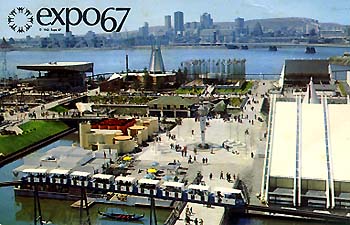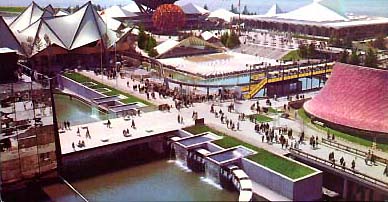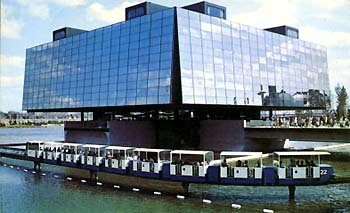
When we think about monorail systems at the several World's
Fairs that have occurred in the century about to end, we are usually
reminded of the two most famous ones: the ALWEG monorail at the
Seattle World's Fair of 1962 and the AMF monorail at the 1964
New York World's Fair. For extra points, we could name fairs with
no longer functioning monorails like Expo 86 in Vancouver, the
1984 World's Fair in New Orleans, the 1876 United States International
Exhibition in Philadelphia, and the little known HemisFair in
San Antonio, Texas.
Many who have visited it do not know that they have seen a permanent
World's Fair of sorts, but Walt Disney World's Epcot is certainly
an ever-changing vision of what our future, and indeed, our present
should be like. ('Minus the long lines, I hope!) It is no coincidence,
that the normally "for-transportation-only" monorail
to Epcot enters the park first instead of dropping off arriving
guests unceremoniously at the entrance. As such, it is PART of
that rosy future that Walt, before his death in 1966, wanted to
show visitors to Disney World. But did you know, that our northern
neighbors (to use a cliché phrase) held an exposition of
their own, carried guests around it with a monorail system, and
still operate part of that system today?
 The
Montreal International and Universal Exposition, or Expo 67 for
short, was held on two islands built in the St. Lawrence River
for the fair. Massive feats of engineering were pulled off to
double the size of one of the islands and to create from scratch
the second, build a new bridge to them, and to construct an entirely
new subway--the Montreal Metro--to help move all of the visitors
to the fair. Huge pavilions were constructed by the the myriad
countries of the world, by geographic regions of the United States
and Canada, and by corporations intent on advertising their products
and advancements. (And you thought Epcot was the first big sell-out
with AT&T, MetLife, and United Technologies "presenting"
the exhibits!) To move guests around between the two islands and
among the exhibit buildings a monorail system was built which
utilized some interesting design elements. The
Montreal International and Universal Exposition, or Expo 67 for
short, was held on two islands built in the St. Lawrence River
for the fair. Massive feats of engineering were pulled off to
double the size of one of the islands and to create from scratch
the second, build a new bridge to them, and to construct an entirely
new subway--the Montreal Metro--to help move all of the visitors
to the fair. Huge pavilions were constructed by the the myriad
countries of the world, by geographic regions of the United States
and Canada, and by corporations intent on advertising their products
and advancements. (And you thought Epcot was the first big sell-out
with AT&T, MetLife, and United Technologies "presenting"
the exhibits!) To move guests around between the two islands and
among the exhibit buildings a monorail system was built which
utilized some interesting design elements.
First, the Minirail, as it was called, operated two different kinds of trains on three different loop systems. One set of trains was constructed in Switzerland in 1964. The other set of trains was constructed in Montreal especially for the expo. Secondly, the system ran over water, through the giant "skybreak geodesic dome" of the United States Pavilion (What is it with the "big ball" at these things? Look at the Perisphere at the '39 World's Fair, the Unisphere at the '64 World's Fair--or is that thing even still there after the movie Men in Black?--[editor note: the 1964 Unisphere still stands!], and the theme pavilion at Expo 86, not to mention Spaceship Earth at Epcot.), and beneath water falls while giving its passengers an all-inclusive view of the fairgrounds while whisking them on their way to their next destination.
The fare structure for the system called for forty cents per
passenger on the two small loops and the more extensive "blue"
line--so named because of the color of the trains--charged fifty
cents to "ride where you wish". The trains became so
crowded with people that new passengers often could not board.
After revising the fee to fifty cents for a half circuit and giving
the boot to "looky-loo's" and "seat squatters",
the trains became a little less popular and the serious passengers,
those in need of transport and not just a place to sit with an
ever changing view, were able to get to their destinations with
a more reasonable wait time for spaces on board. Intended originally
to be operated by a concessionaire, the fair corporation decided
to maintain ownership and operations and justified this decision
by drawing seven million passengers on the system in just the
first three months of the operation. (Think of how quickly it
must have paid for itself!)
 The Blue Line consisted
of six passenger stops near major pavilions. Besides passing over
and under its own tracks, passing beneath the scenic water falls
near the pavilions of Quebec and Ontario, and rolling through
the U.S. pavilion, it also ducked under the standard gauge elevated
rapid transit Expo Express. The stations were named for the nearest
"major pavilion or well known landmark for which a bi-lingual
designation" could be employed: Metro, Agriculture, Theme,
and Canada. Interestingly, two of the lines' stations were "double
stops", that is, Agriculture and Theme stations were stops
for trains going either direction as the track eventually came
back through on the other side of the platform. This line was
4.2 miles long with thirty two trains, each made up of nine cars.
One hundred and two passengers could fit in the 125 foot long
train. Designed by the Swiss firm of Maschinenfabrik Habegger,
their running gear and automatic control systems were completed
by carbodies and superstructures built by Hawker Siddely in Montreal.
Trackage was built by Dominion Bridge Company to Habegger specs
and consisted of double "I" beams supported on "A"
frames up to forty feet high. Incredibly, the trains climbed ten
percent grades and regularly turned radii of fifty feet! Try that
with light rail! Rubber tires were driven by 7-1/2 horsepower
D.C. motors capable of moving the trains at a blistering 7-1/2
miles per hour. The Blue Line consisted
of six passenger stops near major pavilions. Besides passing over
and under its own tracks, passing beneath the scenic water falls
near the pavilions of Quebec and Ontario, and rolling through
the U.S. pavilion, it also ducked under the standard gauge elevated
rapid transit Expo Express. The stations were named for the nearest
"major pavilion or well known landmark for which a bi-lingual
designation" could be employed: Metro, Agriculture, Theme,
and Canada. Interestingly, two of the lines' stations were "double
stops", that is, Agriculture and Theme stations were stops
for trains going either direction as the track eventually came
back through on the other side of the platform. This line was
4.2 miles long with thirty two trains, each made up of nine cars.
One hundred and two passengers could fit in the 125 foot long
train. Designed by the Swiss firm of Maschinenfabrik Habegger,
their running gear and automatic control systems were completed
by carbodies and superstructures built by Hawker Siddely in Montreal.
Trackage was built by Dominion Bridge Company to Habegger specs
and consisted of double "I" beams supported on "A"
frames up to forty feet high. Incredibly, the trains climbed ten
percent grades and regularly turned radii of fifty feet! Try that
with light rail! Rubber tires were driven by 7-1/2 horsepower
D.C. motors capable of moving the trains at a blistering 7-1/2
miles per hour.
The Yellow Minirail trains ran on two loops of 1.1 and 1.3
miles long. Twelve trains on each line with a consist of sixteen
cars each could carry sixty passengers per vehicle. These smaller
trains were only one hundred and five feet long and ran on a slightly
different track structure making the two types of trains non-interchangeable.
Again, rubber tires were employed powered by 2 horsepower D.C.
motors.
Amazingly, these trains were taken out of storage for Expo 67.
They had been utilized at the Swiss International Exhibition in
Lauzanne in 1964 where they were manually controlled before being
"recycled" with automatic controls for the Montreal
fair. Similarly, the 1984 World's Fair (New Orleans, LA) UMI monorails
are being re-used at Miami's Metrozoo in Florida and the Expo
86 Von Roll trains are currently in use at Alton Towers in Great
Britain. The two yellow loops were operated around Ile Ste. Helene
and La Ronde, the amusement park section of the expo. After the
official end of Expo 67 many exhibits and their sponsors changed,
for instance the U.S. pavilion became a giant aviary and semi-exotic
zoo. The new exhibition was called "Man and His World".
By the way, an international bureau regulates the length of time
that an Exposition or World's Fair may run to limit the amount
of time that a city may monopolize the world's attention at the
expense of other cities with aspirations towards hosting a fair.
To this day, the La Ronde amusement park exists and STILL has
its yellow line minirail, the last remnant of a major exhibition
that is usually not the first to come to mind when thinking of
World's Fairs and their monorails.
The following references were used for this article:
"The Minirail at Expo 67 and Man and his World" by Anthony
Clegg
"Expo 67, Official Guide" published by Maclean-Hunter
 / back to the Novelty Monorails index / back to the Novelty Monorails index
|